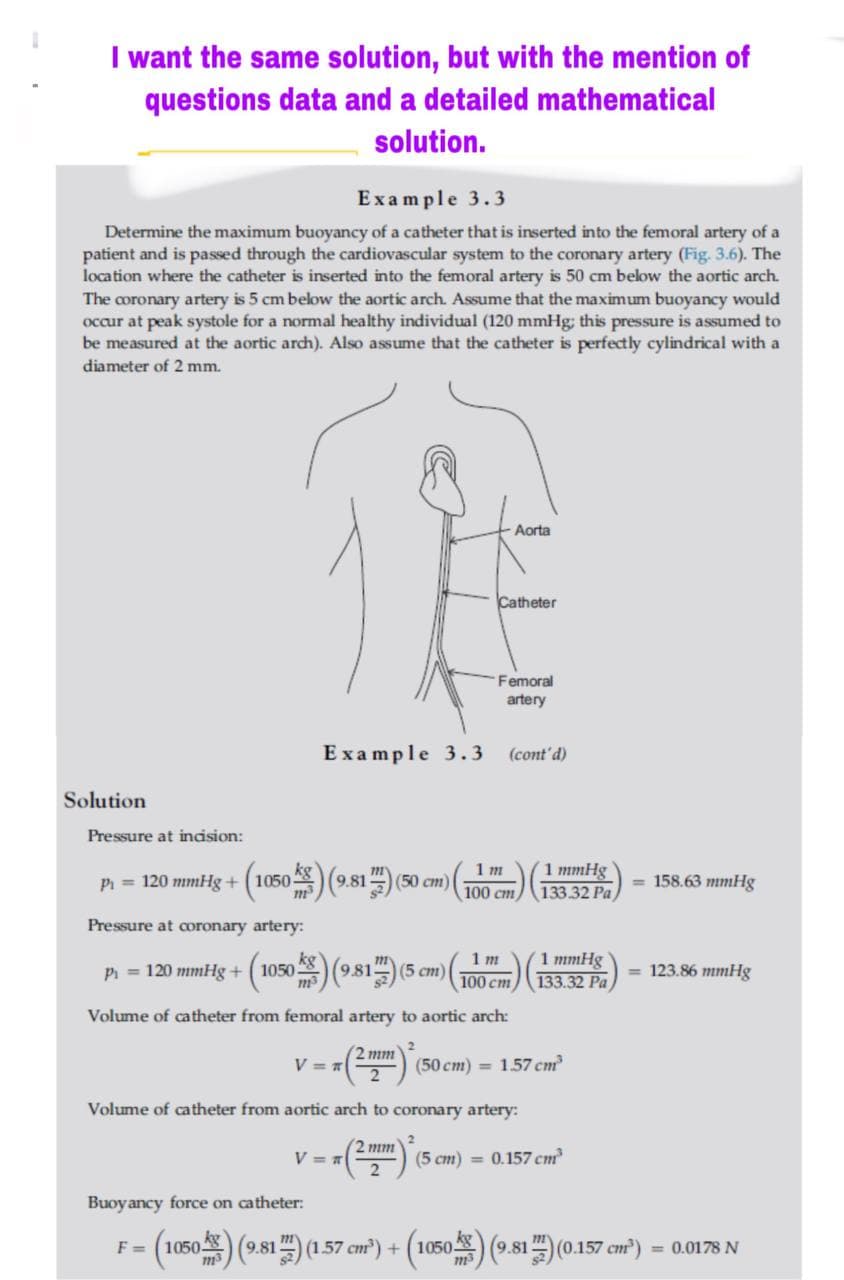I want the same solution, but with the mention of questions data and a detailed mathematical solution. Example 3.3 Determine the maximum buoyancy of a catheter that is inserted into the femoral artery of a patient and is passed through the cardiovascular system to the coronary artery (Fig. 3.6). The location where the catheter is inserted into the femoral artery is 50 cm below the aortic arch. The coronary artery is 5 cm below the aortic arch. Assume that the maximum buoyancy would occur at peak systole for a normal healthy individual (120 mmHg; this pressure is assumed to be measured at the aortic arch). Also assume that the catheter is perfectly cylindrical with a diameter of 2 mm. Aorta Catheter Femoral artery Example 3.3 (cont'd) Solution Pressure at indision: 1 m 100 cm 1 mmHg 133.32 Pa Pi = 120 mmHg+ (1050- 9.81 (50 cm) = 158.63 mmHg Pressure at coronary artery: Pi = 120 mmHg + ( 1050- m 1 m 100 cm 1 mmHg 133.32 Pa (5 cm) = 123.86 mmHg Volume of catheter from femoral artery to aortic arch: 2 mm (50
I want the same solution, but with the mention of questions data and a detailed mathematical solution. Example 3.3 Determine the maximum buoyancy of a catheter that is inserted into the femoral artery of a patient and is passed through the cardiovascular system to the coronary artery (Fig. 3.6). The location where the catheter is inserted into the femoral artery is 50 cm below the aortic arch. The coronary artery is 5 cm below the aortic arch. Assume that the maximum buoyancy would occur at peak systole for a normal healthy individual (120 mmHg; this pressure is assumed to be measured at the aortic arch). Also assume that the catheter is perfectly cylindrical with a diameter of 2 mm. Aorta Catheter Femoral artery Example 3.3 (cont'd) Solution Pressure at indision: 1 m 100 cm 1 mmHg 133.32 Pa Pi = 120 mmHg+ (1050- 9.81 (50 cm) = 158.63 mmHg Pressure at coronary artery: Pi = 120 mmHg + ( 1050- m 1 m 100 cm 1 mmHg 133.32 Pa (5 cm) = 123.86 mmHg Volume of catheter from femoral artery to aortic arch: 2 mm (50
Elements Of Electromagnetics
7th Edition
ISBN:9780190698614
Author:Sadiku, Matthew N. O.
Publisher:Sadiku, Matthew N. O.
ChapterMA: Math Assessment
Section: Chapter Questions
Problem 1.1MA
Related questions
Question

Transcribed Image Text:I want the same solution, but with the mention of
questions data and a detailed mathematical
solution.
Example 3.3
Determine the maximum buoyancy of a catheter that is inserted into the femoral artery of a
patient and is passed through the cardiovascular system to the coronary artery (Fig. 3.6). The
location where the catheter is inserted into the femoral artery is 50 cm below the aortic arch.
The coronary artery is 5 cm below the aortic arch. Assume that the maximum buoyancy would
occur at peak systole for a normal healthy individual (120 mmHg; this pressure is assumed to
be measured at the aortic arch). Also assume that the catheter is perfectly cylindrical with a
diameter of 2 mm.
Aorta
Catheter
Femoral
artery
Example 3.3
(cont'd)
Solution
Pressure at indision:
120 mmHg + (1050) 9.81 (50 cm)
1 m
100 cm
1 mmHg
133.32 Pa
Pi =
= 158.63 mmHg
Pressure at coronary artery:
1 m
100 cm
1 mmHg
133.32 Pa
Pi = 120 mmHg +
1050-
(5 cm)
= 123.86 mmHg
Volume of catheter from femoral artery to aortic arch:
2 mm
(50 cm) = 157 cm
Volume of catheter from aortic arch to coronary artery:
2 mm
V =
(5 cm) = 0.157 cm
Buoyancy force on catheter:
(1050)(281)(157 m") + (1050)(. 51)(0.157 em")
F =
9.81
(1.57
(9.81
= 0.0178 N
Expert Solution
This question has been solved!
Explore an expertly crafted, step-by-step solution for a thorough understanding of key concepts.
This is a popular solution!
Trending now
This is a popular solution!
Step by step
Solved in 2 steps with 2 images

Knowledge Booster
Learn more about
Need a deep-dive on the concept behind this application? Look no further. Learn more about this topic, mechanical-engineering and related others by exploring similar questions and additional content below.Recommended textbooks for you

Elements Of Electromagnetics
Mechanical Engineering
ISBN:
9780190698614
Author:
Sadiku, Matthew N. O.
Publisher:
Oxford University Press

Mechanics of Materials (10th Edition)
Mechanical Engineering
ISBN:
9780134319650
Author:
Russell C. Hibbeler
Publisher:
PEARSON

Thermodynamics: An Engineering Approach
Mechanical Engineering
ISBN:
9781259822674
Author:
Yunus A. Cengel Dr., Michael A. Boles
Publisher:
McGraw-Hill Education

Elements Of Electromagnetics
Mechanical Engineering
ISBN:
9780190698614
Author:
Sadiku, Matthew N. O.
Publisher:
Oxford University Press

Mechanics of Materials (10th Edition)
Mechanical Engineering
ISBN:
9780134319650
Author:
Russell C. Hibbeler
Publisher:
PEARSON

Thermodynamics: An Engineering Approach
Mechanical Engineering
ISBN:
9781259822674
Author:
Yunus A. Cengel Dr., Michael A. Boles
Publisher:
McGraw-Hill Education

Control Systems Engineering
Mechanical Engineering
ISBN:
9781118170519
Author:
Norman S. Nise
Publisher:
WILEY

Mechanics of Materials (MindTap Course List)
Mechanical Engineering
ISBN:
9781337093347
Author:
Barry J. Goodno, James M. Gere
Publisher:
Cengage Learning

Engineering Mechanics: Statics
Mechanical Engineering
ISBN:
9781118807330
Author:
James L. Meriam, L. G. Kraige, J. N. Bolton
Publisher:
WILEY